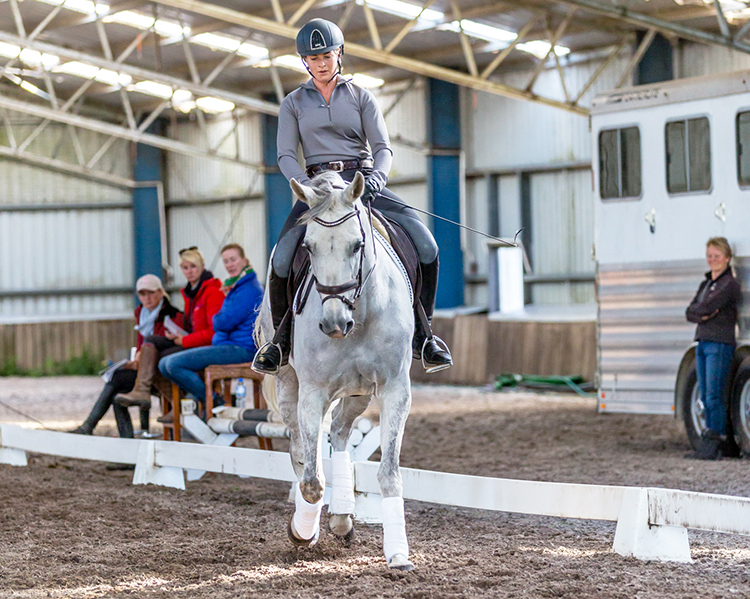 Photos by OneEyedFrog Photography
Photos by OneEyedFrog Photography
When young Showjumping rider, Megan Joyce lined up for her lesson with dressage trainer, and international top ten competitor, Princess Nathalie zu Wittgenstein, who better to send to record the interaction, than top showjumping coach, Michelle Strapp…
Equestrian disciplines are so different, and yet good equestrian trainers over all disciplines actually have much in common with their training principles. All riders have the love for the horse, and we all want to develop the full potential of our equine partners. The horse learns from a minimum level of discomfort, and a maximum amount of release to truly yield to the rider’s aids. Therefore the horse and rider can work in harmony. So there is no logical reason why dressage and showjumping training principles at the basic level, should not be the same.
The lesson with Princess Nathalie working with young showjump rider, Megan Joyce, once again confirmed that the principles of dressage training are related to the principles of showjumping training.
Princess Nathalie zu Sayn-Wittgenstein of Denmark is an international dressage rider and renowned trainer. Nathalie was giving a lesson to Megan on Blackall Park Cha Cha, a 7-year-old Daley K, who is jumping 1.30m competitions. My first impression was that Nathalie believed showjumping training has become more removed from the dressage principles of training.
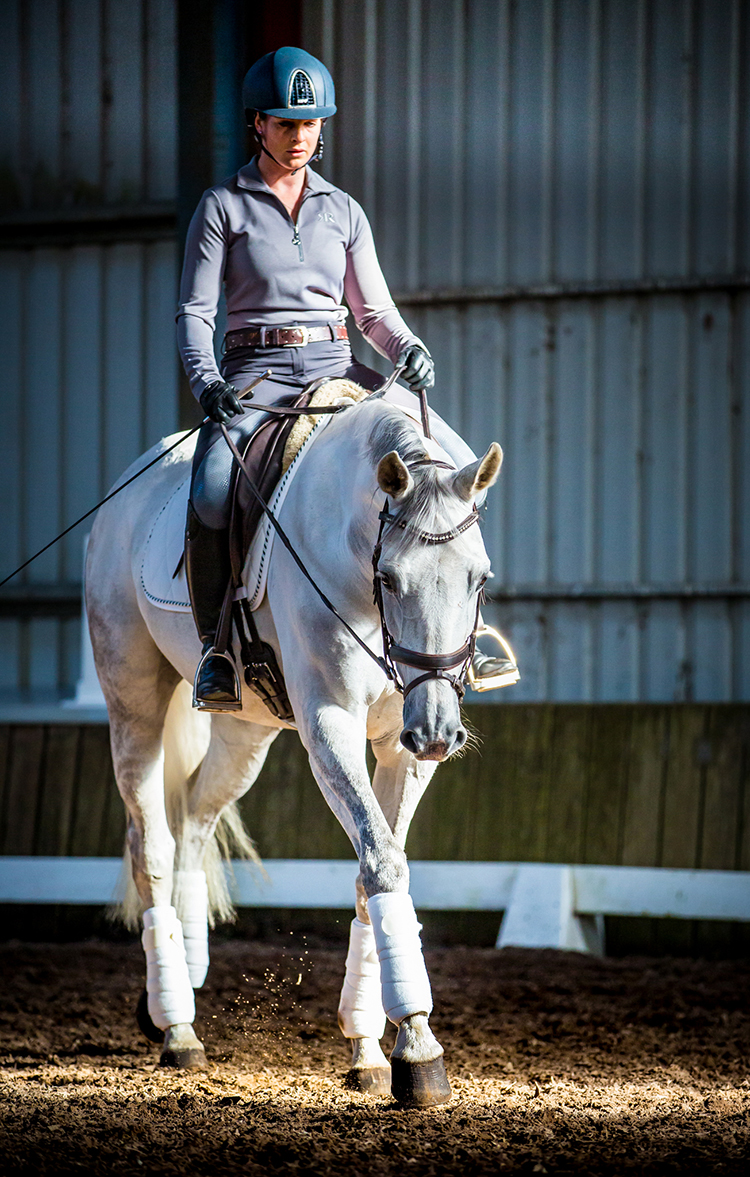
Nathalie first comments that the horse is good looking and well muscled. She’s pleased Megan has presented in a dressage saddle. Nathalie was pleased the horse could walk and trot in a nice outline as she was watching Megan warm up for the lesson.
The lesson began at the trot in a normal conventional way. Nathalie is asking Megan to push her horse from behind: “think a bit shoulder in through the corners, keep your leg on.”
Time for canter. Megan’s horse was pushing its hind quarters to the inside.
“Keep her straight, don’t let her push at your inside leg, ride a little shoulder in, in the canter… keep your dressage whip in the outside hand, keep her jumping from behind, play a little with your tempo, forward and back, forward and back tap her on the outside hind so she keeps skippy on the outside hind…”
Megan attempted a flying change and the horse busted through the bridle: “oops, does not matter…” Nathalie was more focused on addressing Megan’s horse from falling in, and making transitions, as exercises to assist in improving the flying changes, bringing it back to the basics to prepare for a change.
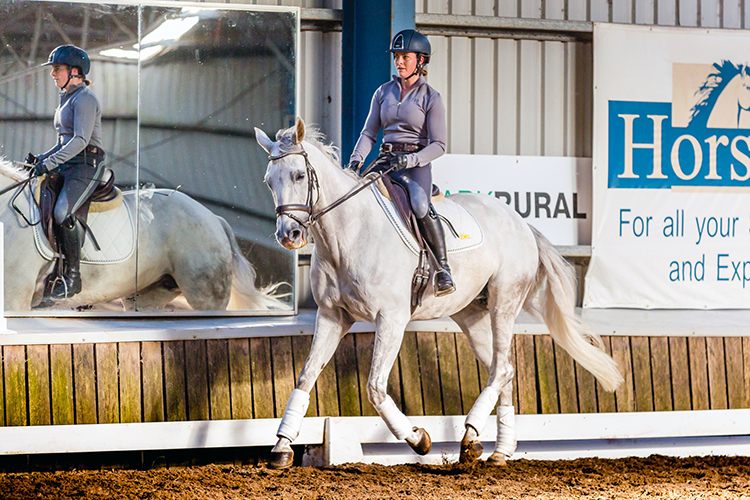
Back to the trot work: “Be careful she doesn’t fall on your inside leg in that transition, be careful to address her falling on your inside leg as it will affect you in your turns on course. Keep your leg on into the transitions so she knows she can go into the contact”.
Megan again attempts another change of rein, but the horse anticipates the change and runs through bridle more expressively. Megan is trying to get her back on track: “Leg on, then if she pulls on you, she pulls on her own hind end, because you have your leg on.”
Nathalie was trying to get Megan to ride forward into the resistance, not just to pull back. Megan discusses her main problem with Nathalie: “My main problem is the mare is downhill in the canter.”
Nathalie suggests: “Lots of small transitions where you bring her back, but then she has to spring off the leg again to go forward.”
Megan starts to canter again: “Tap her from behind, activate the hind end without losing the shoulder, think a little shoulder in while in the canter, “DON’T LET HER COME IN WITH THE HIND QUARTERS!”
Nathalie was trying to teach Megan to keep the horse straight and quick with the hind leg in the canter, which will improve the power of the canter and the jump.
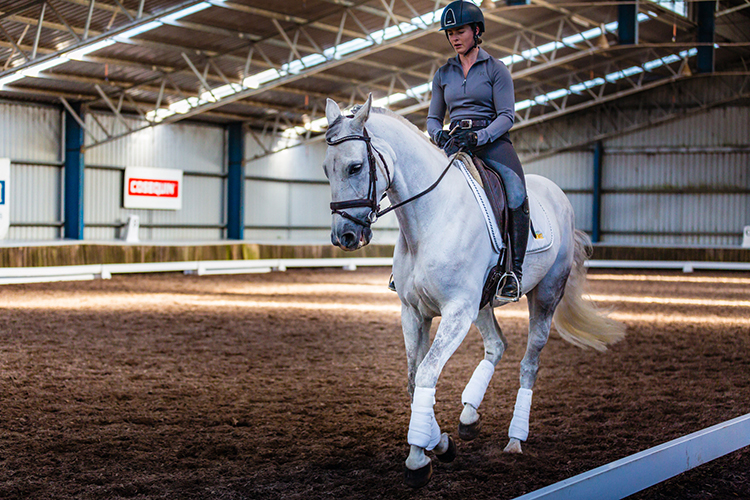
Megan tries another change, but the horse takes off resisting the contact, and almost jumps on us. Megan corrects this by going into a small half volte, attempting another change from right to left, and gets it, but falls to the trot.
“Canter, canter, canter, put her back in the canter with shoulder in, then go forward, more forward, more forward, FORWARD, more forward! There, there that’s it, correct.”
Megan’s horse wanted to fall behind her leg, so Nathalie wanted her to ride forward to the resistance – the horse was starting to accept going forward to the contact.
Megan tries another change, and again the horse runs through bridle and loses line, but gets the change in the end: “more inside leg, she needed to be more off your inside leg.” Nathalie wanted Megan to control the shoulders before the change, keeping the new shoulder light.
At that point Nathalie finished with the lesson and Megan and Nathalie were very pleased with the progress and Megan’s work.
INTERVIEW TIME…
You seemed very surprised, actually pleased to see that Megan’s horse worked towards dressage principles…
“Yes.”
In my opinion jumpers should be training their horses every day with basic dressage work, would you agree?
“Absolutely.”
The fundamentals of basic training is to help a horse become soft, balanced and powerful. The horse must understand and yield to the aids so that its body can work correctly for the rider. This is as important in showjumping as it is dressage…
“Absolutely, this is a problem we see in Europe.”
So this is really nice to see young riders who are trying to head this way with their training isn’t it, it’s refreshing…
“For me it’s absolutely refreshing I’m really quite taken aback.”
Sometimes I wonder why there is such a chasm between showjumping and dressage…
“I think that’s what I sort of see in Europe, and also my, father-in-law, Heinrich-Wilhelm Johannsmann, he was a very good jumping rider and goes out and gives a lot of clinics. I think the young people just want to go quick, quick, quick, they just think of the jumping, some are forgetting the need for the correct basic training.”
Use the link to read the article with Kaiser Johnannsmann
The top showjumper riders and trainers do work for the same principles. Rhythm, relaxation, connection, straightness, impulsion and collection, it is also very important ingredients for a top class showjumper…
“And if the horse makes a mistake they call it a stupid horse, when they maybe could have avoided that mistake by riding the horse more through. Nowadays the young people don’t think of that anymore, they just blame the horse. And that’s what my father-in-law is really going back to. Young riders need to start understanding again that it’s not only if the horse can jump 150 or 160cm. It’s having the horse powerful enough and responding to the aids. Then you can work with the horse between the obstacles and create the best approach to allow the horse to jump to its fullest potential.”
If all horses should start with the same basic principles of training, at what point do you think that showjumper and the dressage training cannot compliment each other? Really jumping is just dressage between jumps, it’s how we get to the jump that is really important, but there must come a point where the aspects of the training changes. I would think it was when you start to ask higher and higher collection where the dressage horse has to wait for the riders very light aids, and the jumping horse, to jump fences well is a little stronger to the bridle, and a little more independent in their thought pattern…
“Absolutely I would also say the M level in Germany (125cm) the trainer should probably specialise, but this is also the problem of the modern time, you either go the jumping line, or you go to the dressage line.” (article continues below)
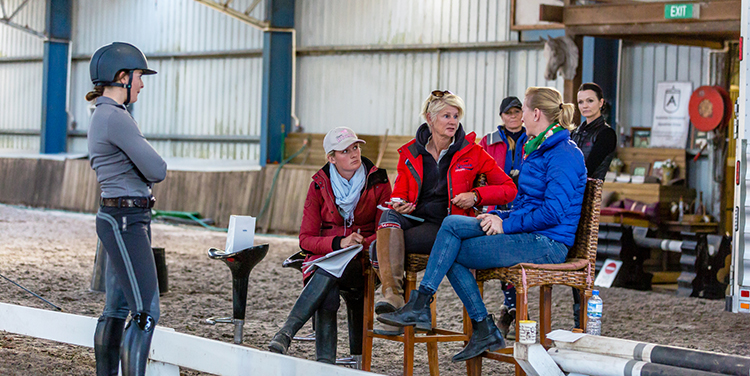
Yes in the past it wasn’t like that in Europe, it was all the same basic training for dressage horses and showjumping…
“No it wasn’t like that, and that again is something my father-in-law is trying to get more together again.”
I would love to meet your father-in-law…
“Good riding is good riding, and the jumps come in between. The riding in between fences should absolutely be the same, and you should be able to train without draw reins. Okay there are some jumping horses, that in their breeding, are not born to go easily on the bit, so for them it is more difficult to get them round, and go over the back, but that’s more in the breeding. But again the jumping riders should try and get them rounded without draw reins, perhaps with the assistance of a martingale.”
Improve the riders’ basic training skills so they can bring out the best of their horse?
“But then again the younger generations think draw reins on, head down and we canter around 100mph, 5 circles left, 5 circles right then back in ring again.”
Obviously you are seeing it in Europe as much as we are seeing it here…
“Absolutely. It’s when you then get into the higher classes again like the Global Champions, then the picture changes, but again also there… Some of the riders in the Global Champions tour are not such good riders, they just have really, really good horses.”
So you were very happy with Megan?
“Yes, and I really liked it, you’ve done nice work, especially since Michelle says the offspring of that stallion are known not to be easy.”
Megan agreed that Cha Cha has been very difficult to train, but Nathalie was very impressed with Megan’s patience and direction of training.
All horses can become very difficult and unpleasant to ride if not trained correctly. If you deal with the horse with force not patience, they become confused and develop resistance and may become unrideable, riders may then respond by putting on stronger bits, draw reins and bigger spurs, not the correct solution. It can be very short-term fix, especially in the wrong hands…
“And if you also see that range of bits jumping riders are allowed to use and what there is on the market is incredible. And then what dressage riders are allowed to use, I mean it’s day and night!!! We are actually doing the same sport on the ground!!!” (article continues below)
Yes we are working with the same animal, I mean if showjumping horses had five legs and dressage horses had four, well maybe there could be a difference. As you said, conformation can make the training more difficult, but if you understand the way a horse works mentally and physically, which is what good training is about, it helps…
“Yes absolutely.”
Jumping horses spend more time in competition at a much faster and stronger pace so bits can compliment the ride, but it is not the main answer to training…
“Yes.”
Thanks it was great to talk to you, and interesting to talk to you on the subject of training horses.
Megan: “Thanks Nathalie for letting me ride with you.”
Nathalie: “No, no, pleasure, you have done a really good job with Cha Cha.”
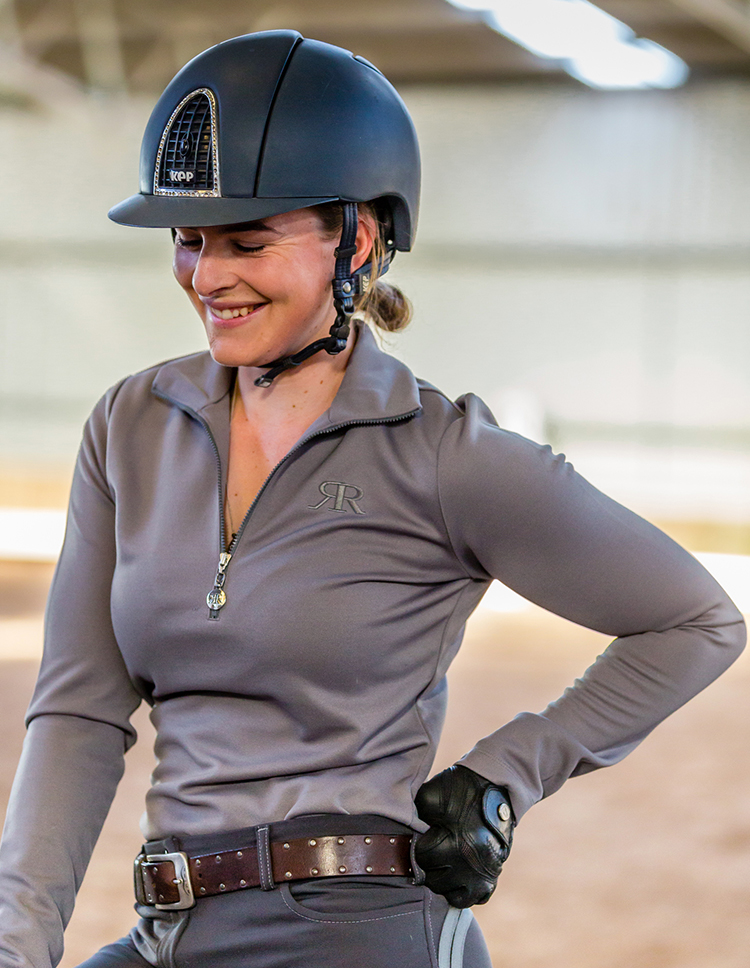 FINAL WORDS WITH MEGAN…
FINAL WORDS WITH MEGAN…
Daley K’s are known to have a lot of ability as showjumpers, but take a lot of patience to train…
“That’s why the flat work has helped in a way. You get on course and lose a lot of what you do on the flat at home, so you have to work harder at home to be able to do something in the ring.”
What did you get from today? What’s the main thing you are going to take away from today, and how is that going to affect how you school this horse and other horses at home in the future?
“It’s just good to be pushed a bit, you get in your own square and you don’t get to push out of your comfort zone, so yeah it’s great, it’s very good. I need to use the exercises Nathalie gave me. We forget to use exercises, really training, exercises to help her carry herself, that’s what Cha Cha needs. Plus I will use these exercises on other my horses.”
How do you feel what you did today is going to relate to your jumping ride?
“Well this mare dramatically falls on into her forehand on landing, to the right, and that’s what we majorly worked on today, so it will definitely coincide. If I work enough on it at home, it will apply more when I am riding a course. It helps especially when you do think of your inside leg and outside rein, you think of that when you land anyway, so what we were working on a lot today will help a lot when I am riding a course.”



